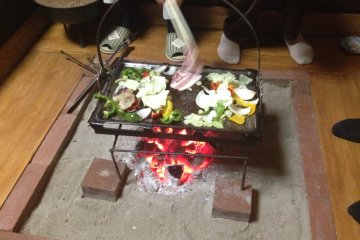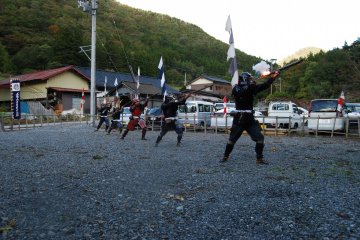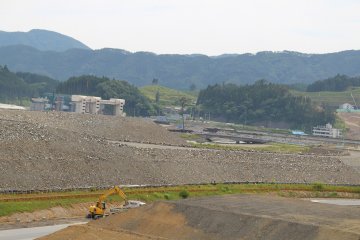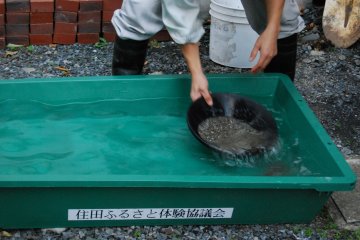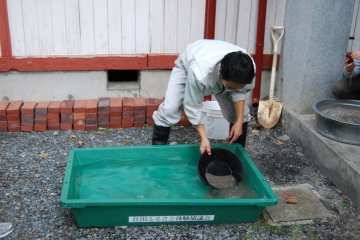The fast flowing streams and rivers of the Kessen area of Sumita town house a hidden secret in their silts. Avert your gaze from the attractive scenery of mountains and forests that characterise the Sumita area and peer into the depths of a gushing stream and you may see the odd sparkle that is nothing less than a speck of gold. Don't be fooled though, there is plenty of iron pyrite (fool's good) to put you off track.
According to historical evidence, Sumita was known a major source of gold deposits as early as the Nara period (710-794). This historical connection with gold is still found today in place names and in nearby cultural heritage, such as the Konjikido (Golden Hall) of the Temples and Monuments of Hiraizumi, a World Heritage Site. The Konjikido, itself coated in gold leaf, is an outstanding example of Heian Period (794-1185) architecture and sculpture. Analysis of the gold from the Konjikido showed it to have the same chemical make up as that from the Kessen area, creating a strong argument that Kessen was in fact the source of gold used in the construction of the Konjikido. The area's gold resources were also extensively mined during the Edo period.
With the rise in green tourism, Sumita's streams and rivers are attracting renewed attention from domestic and overseas tourists. Although panning for gold in local rivers is possible, I had the opportunity to practice the ages old technique of sifting for gold at the local Folk History Information Center.
The instructor placed specks of gold in various troughs containing river silt and clean, fresh water. Using a sturdy earthenware bowl, silt and water is scooped into the bowl, and holding the rim either side with both hands, it is gently rocked back and forth at a shallow downward angle. Through this action, the lighter water and silt are gradually returned to the trough leaving the denser materials, small pebbles, fool's gold and possibly even gold in the bottom of the bowl! I was lucky enough to find a small speck of Kessen gold which the instructor kindly placed inside a small display bottle. All successful prospectors receive a display bottle to take home, and if you're not so lucky, the instructor may present you with one if you tried hard.
The idea of panning for gold may not sound very exciting but actually it is surprisingly therapeutic! It's a delight to find some hidden gold; a true reward for your effort. If this is of any encouragement, the guide assured us that it is still possible to find nuggets of gold if you are willing search hard enough.
Along with cave exploration, hiking, mountain climbing and cycling, prospecting for gold makes for a compelling addition to the itinerary of any traveller looking to soak up the clean air and green surroundings of the area while sifting through river sands in search of traces of the area's once extensive gold deposits.
For more information about prospecting for gold in Sumita please contact Tohoku@gmail.com.



